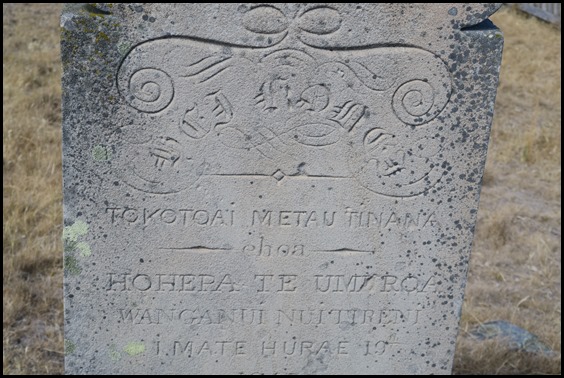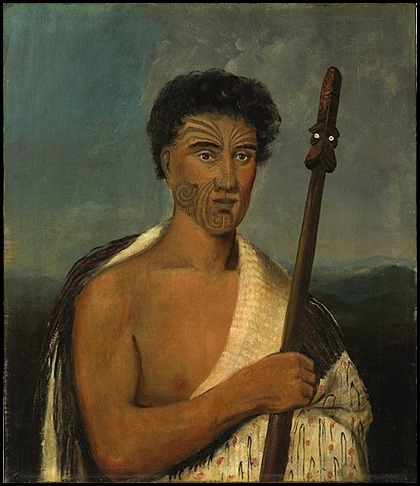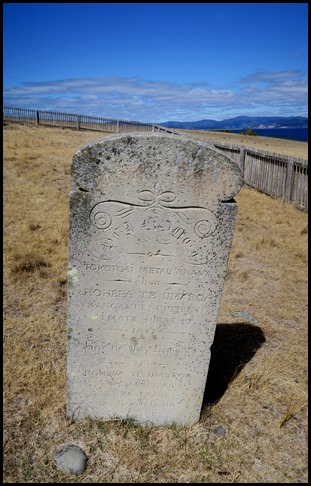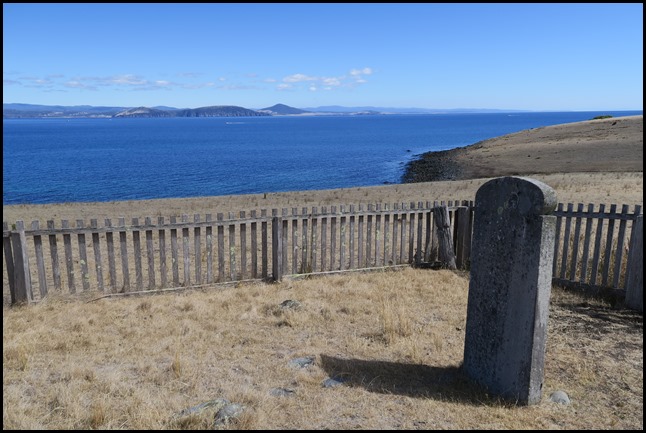Hohepa Te Umuroa

|
Hohepa Te Umuroa
- Maria Island
Cemetery
 Grave number 15. From “Five Days on Maria Island”, the Mercury, 23rd of March 1876:- One more, and I have done. It stands in a corner, hard by the “phantom moaning of a circle sea, alone : – HEI
KONET
TOKOTOAI METAUIMANA ehoa HOHEPA TE UMUROA WANGANUI NUITIRENE IMATE HURAK 19th 1847
We turned away sadly from the grave of this stranger who sleeps his last sleep in a strange land. Outside the burial-ground is to be seen a grave. It appeared to us as though its occupant was not considered worthy of being placed within the sacred enclosure. Telle est la vie ! Besides the graves I have noticed there are many others. Over some the roses were blooming ; others are hidden by luxuriant salt-bushes. The fences and walls have fallen down, and cattle trample over the remains of those who once, perchance, were loved. If the Government is too stingy or too impecunious to expend a few pounds per annum in keeping the last resting place of those who served Tasmania in their day – even though there be some of the despised and down-trodden sleeping near them – in repair, surely there are private individuals whose friends repose there who would not begrudge a trifle to prevent the spot from being desecrated, as it will, if untended, certainly become. Better, far better, to level it to the ground, to wipe it out of man’s remembrance, than to leave it as at present-a disgrace to Government and to those whose relatives are buried there.

Hohepa Te Umuroa, 1846 painting by William Duke
Hohepa Te Umuroa (1820’s – 19 July 1847) was a notable New Zealand and political prisoner. Of Māori descent, he identified with the Te Ati Haunui-a-Paparangiiwi. The story of Te Umuroa's capture and subsequent transportation and imprisonment in Tasmania for insurrection is told in The Trowenna Sea by Witi Ihimaera and the opera "Hohepa". Te Umuroa died of tuberculosis in Tasmania, and his remains were repatriated to New Zealand in 1988 with ceremony and prayers.
 The Encyclopaedia of New Zealand tells
us: Hohepa Te Umuroa was a member of Ngati H au of Te Ati
Haunui-a-Paparangi. He may have been born in the early 1820’s. The names of his
parents are not known. He grew to be a tall man of over six feet, with a fine,
large head and an incomplete moko on the left side of his face. According to his
people he did not marry.
Te Umuroa worked for a time as a labourer, but when Te Rangihaeata of Ngati Toa began armed resistance to the settlers in the Wellington area in 1846, he joined other Wanganui Maori who travelled to Te Rangihaeata's pa at Taupo, Porirua. In May 1846 he took part in the attack on Almon Boulcott's farm in the Hutt Valley. It was this incident which prompted Governor George Grey to arrest Te Rauparaha in July that year, and keep him captive without trial, first on the Calliope and then in Auckland. The following month Te Umuroa also fell victim to Grey's questionable activities. On the 14th of August 1846 he was captured near Paripari, in the Pauatahanui hills, Porirua, along with six other Wanganui Maori: Te Waretiti, Matiu Tikiaki, Te Kumete, Topi, Matai-umu and Te Rahui. Their captors were a party of Te Ati Awa led by Aperahama Ngatohu and Nepetarima Ngauru, part of a force of over 100 Te Ati Awa assembled by Wiremu Kingi Te Rangitake to assist the government in searching for supporters of Te Rangihaeata. When this party approached the huts where Te Umuroa and his companions were sheltering, they shook hands with the men before taking them prisoner. On the return march to Waikanae they were met by Sergeant R. B. Sayer of the Armed Police Force, who took the captives to the police station at Waikanae. Later they were sent to join Te Rauparaha on the Calliope. Under the terms of the martial law operating in the area, the Wanganui men should have been treated as prisoners of war. Grey, however, chose to regard them as rebelling against the Queen's authority, and ordered a court martial of questionable legality, directing the court as to its verdict should they plead guilty. Te Umuroa and his companions had only an interpreter to plead their cause; none spoke sufficient English to conduct a defence and they were not given legal counsel. They pleaded guilty, and on the 12th of October 1846 were convicted of rebellion against the Queen, aiding Te Rangihaeata, and possession of one of Her Majesty's firearms. They were sentenced to be 'transported as Felons for the Term of their Natural lives.' After the trial the seven were taken to Auckland, to be sent to Hobart Town, Van Diemen's Land (Tasmania), and on to a penal colony. The Castor arrived at Hobart Town on the 16th of November with five of the group and seven other convicts on board. Grey kept Matiu Tikiaki and Topi in Auckland, supposedly to testify in a coming trial of Te Rauparaha. The arrival of the Maori prisoners, wearing traditional dress, created much interest. They were visited by the local press, who were concerned at their living conditions and vigorous in their criticism of the transportation. Normally convicts were sent on to Norfolk Island, but the acting lieutenant governor of Van Diemen's Land, C. J. La Trobe, decided to send the men to Darlington probation station, on Maria Island off the coast of Van Diemen's Land, which was regarded as a more humane institution. There they were given separate huts from the main dormitory, which housed 400 convicts. They remained subjects of attention. All five were painted by the colonial artist John Skinner Prout; these paintings are now held at the Art Gallery of New South Wales. Another portrait of Te Umuroa, thought to have been painted by William Duke, also survives. In mid April 1847 Te Umuroa fell seriously ill with tuberculosis. His health deteriorated through the winter. On 19 July 1847 the prison foreman, J.J. Imrie, wrote in his diary: 'At 4 am visited the Maoris. Found Hohepa very nearly gone. At 5 am he breathed his last without a struggle.' Te Umuroa was buried the next morning, in the small public cemetery on the island, on a bleak hillside, rather than in the convict cemetery. The funeral service was read in Maori by Imrie at the graveside. An anonymous benefactor later erected a headstone over the grave. Te Umuroa's death prompted the Australian authorities to action. Both La Trobe and the Colonial Office queried the legality of the court martial and transportation. Eventually the four remaining prisoners were released and returned to Auckland in March 1848. Te Umuroa's return was not until 1988. After three years of negotiations within and between the New Zealand and Australian governments, six elders of Te Umuroa's tribe travelled to Tasmania to bring him back to his home. He was reburied on the 8th of August 1988 at Roma cemetery, Jerusalem, on the Wanganui River.
 ALL IN ALL AMAZING TO LEARN
SO MUCH ABOUT THE MAN
A SURPRISING FIND AND VERY
INTERESTING |
